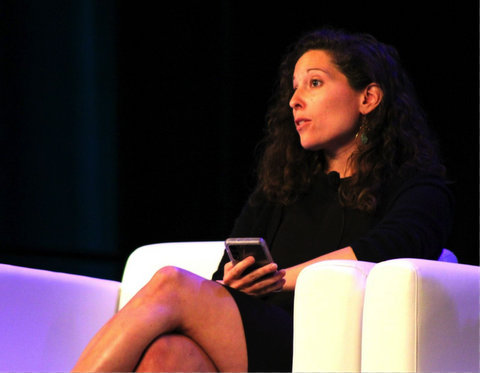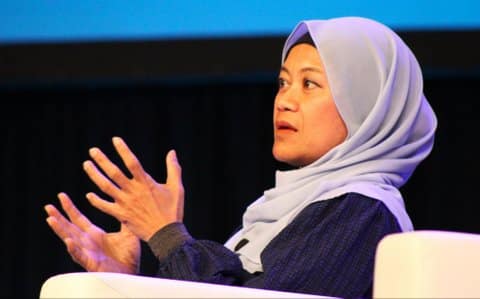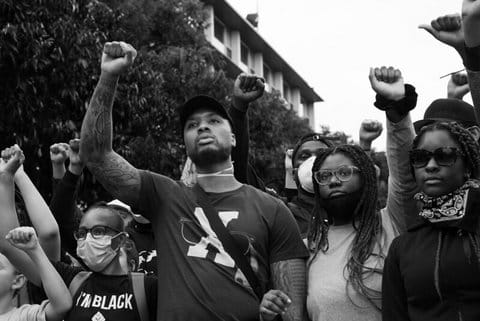
18 Jul Neither Radicalization Nor Efforts to Fight It Exist in a Vacuum

Emma Cardeli of the Boston Children’s Hospital Trauma and Community Resiliency team speaks about how it works to reduce radicalization by reaching out to youth. (Joe Porrello / The CC Pulse)
Editor’s note: The Eradicate Hate Global Summit began in 2021 in response to the mass shooting at the Tree of Life synagogue. Last year, The CC Pulse was there for the first time in service of our Stop the Hate coverage.
By Joe Porrello
PITTSBURGH — Three panelists at the Eradicate Hate Global Summit spoke together about how each of their initiatives is taking a different angle in minimizing radicalization to cover as many bases as possible.
“Each of our efforts aims to come together to create a larger mosaic that allows us to approach this problem with a whole of society, multidisciplinary and comprehensive solution,” said Jillian Hunchak, research analyst at the Canada Centre for Community Engagement and Prevention of Violence.
According to the Anti-Defamation League, right-wing extremist terror incidents in the U.S. have multiplied more in the past six years than any other time along their steady incline over the last two decades.
Hunchak says family members, neighbors, classmates and friends sometimes recognize the signs of radicalization but often don’t know who to turn to, or sometimes it’s too late to help.
“Our work is going to focus on youth demographics — specifically to help figure out how to spot, understand and respond to these warning signs,” said Hunchak. She said the center’s efforts would be grounded in historical context by drawing on lessons from both past failures and progress in curbing violent extremism in children.
“We know that it’s not enough to make a checklist of concerning behaviors,” said Hunchak. “We are approaching this topic with nuanced context and sensitivity in order to ensure its success… just as violent extremism does not exist in a vacuum, neither does our response to it.”
>>>Q&A: How Youth Become Radicalized and What to Do<<<
And just as the trio of panelists have cast a wide net of prevention around radicalization through their respective initiates, so has the summit itself, which holds different sectors within it called working groups that tackle hate collectively in their particular fields of expertise.
Hunchak says she coordinates with multiple working groups to create a “continuity of care,” approach for youth displaying “red flags.”
Continuance of support is something Brette Steele, the director of prevention and national security at the McCain Institute, had in mind while she helped launch the nationwide SCREEN Hate campaign in 2022 in partnership with Moonshot. The latter mapped and analyzed internet hate around the world, while the campaign offered tools and support for parents and other concerned adults to better guide youth who encounter violent extremism online.
According to the MCcain Institute, the campaign reached over 2 million people over a 10 month span. The name, meant to be a resource in itself, is an acronym:
- Start a conversation with teens and young adults in your life.
- Create an environment where they feel comfortable sharing.
- Remind them that hate-based violence is wrong.
- Engage when they talk about games, videos or social media.
- Enlist the help of a professional if you think your child is at risk.
- Never ignore a threat of violence.
The campaign’s support system includes areas of focus such as media literacy, bystander training, referral systems, threat assessment and management teams, intervention teams, and reintegration assistance.
“Clinically licensed providers are raising their hands and saying, ‘We want to be a resource. We want to help,’ ” said Steele.
As a clinical psychologist research associate at Boston Children’s Hospital with the Trauma and Community Resiliency team, Emma Cardeli says much of the onus on reducing hate lies with professional providers.
“If and when it is appropriate to refer someone to a mental health professional, it’s really critical to ensure that the referral actually counts, that providers have the confidence and competence to identify, assess, manage, and/or treat violence risk as part of mental health services,” she said.
In her experience, Cardeli said, mental health professionals often get very little training in identifying risk factors for violence or conducting assessments with sensitivity to that risk, and it is sometimes not addressed as a core component of treatment.
“The emphasis in graduate school is not on working with people who are harder to engage or resistant to service — who maybe say or do things that make you feel uncomfortable or scared or upset — and this has profound implications for building a mental health workforce that can respond to the needs of individuals at risk of violence,” she said.
Karen L. Smith, a psychotherapist with 25 years’ experience, wrote in Full Living that bigotry can not only considerably compromise licensed professionals’ capacity to empathize and sympathize with clients but can also reduce health experts’ interest in trying.
Healthcare systems themselves also set limitations, according to Cardeli.
“Mental health professionals working in acute or emergency services are often asked to focus their assessments very, very narrowly on determining whether or not someone needs to be hospitalized right now, not on a comprehensive risk management plan or on setting up an array of community-based services that help prevent an act of violence a month from now,” she said.
Through initiatives like each of the panelists’, clients with extremist ideologies now have better-equipped counseling to help them disengage from radicalization or keep them from becoming radicalized in the first place.
This resource is supported in whole or in part by funding provided by the State of California, administered by the California State Library in partnership with the California Department of Social Services and the California Commission on Asian and Pacific Islander American Affairs as part of the Stop the Hate program. To report a hate incident or hate crime and get support, go to CA vs Hate.





No Comments